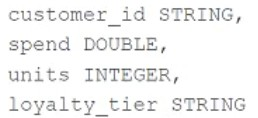Most Recent Databricks-Machine-Learning-Associate Exam Dumps
Prepare for the Databricks Certified Machine Learning Associate Exam exam with our extensive collection of questions and answers. These practice Q&A are updated according to the latest syllabus, providing you with the tools needed to review and test your knowledge.
QA4Exam focus on the latest syllabus and exam objectives, our practice Q&A are designed to help you identify key topics and solidify your understanding. By focusing on the core curriculum, These Questions & Answers helps you cover all the essential topics, ensuring you're well-prepared for every section of the exam. Each question comes with a detailed explanation, offering valuable insights and helping you to learn from your mistakes. Whether you're looking to assess your progress or dive deeper into complex topics, our updated Q&A will provide the support you need to confidently approach the Databricks-Machine-Learning-Associate exam and achieve success.
The questions for Databricks-Machine-Learning-Associate were last updated on May 3, 2025.
- Viewing page 1 out of 15 pages.
- Viewing questions 1-5 out of 74 questions
A data scientist is working with a feature set with the following schema:

The customer_id column is the primary key in the feature set. Each of the columns in the feature set has missing values. They want to replace the missing values by imputing a common value for each feature.
Which of the following lists all of the columns in the feature set that need to be imputed using the most common value of the column?
For the feature set schema provided, the columns that need to be imputed using the most common value (mode) are typically the categorical columns. In this case, loyalty_tier is the only categorical column that should be imputed using the most common value. customer_id is a unique identifier and should not be imputed, while spend and units are numerical columns that should typically be imputed using the mean or median values, not the mode.
Databricks documentation on missing value imputation: Handling Missing Data
If you need any further clarification or additional questions answered, please let me know!
Which of the following machine learning algorithms typically uses bagging?
Random Forest is a machine learning algorithm that typically uses bagging (Bootstrap Aggregating). Bagging is a technique that involves training multiple base models (such as decision trees) on different subsets of the data and then combining their predictions to improve overall model performance. Each subset is created by randomly sampling with replacement from the original dataset. The Random Forest algorithm builds multiple decision trees and merges them to get a more accurate and stable prediction.
Databricks documentation on Random Forest: Random Forest in Spark ML
A data scientist has a Spark DataFrame spark_df. They want to create a new Spark DataFrame that contains only the rows from spark_df where the value in column discount is less than or equal 0.
Which of the following code blocks will accomplish this task?
To filter rows in a Spark DataFrame based on a condition, the filter method is used. In this case, the condition is that the value in the 'discount' column should be less than or equal to 0. The correct syntax uses the filter method along with the col function from pyspark.sql.functions.
Correct code:
from pyspark.sql.functions import col filtered_df = spark_df.filter(col('discount') <= 0)
Option A and D use Pandas syntax, which is not applicable in PySpark. Option B is closer but misses the use of the col function.
A data scientist uses 3-fold cross-validation when optimizing model hyperparameters for a regression problem. The following root-mean-squared-error values are calculated on each of the validation folds:
* 10.0
* 12.0
* 17.0
Which of the following values represents the overall cross-validation root-mean-squared error?
To calculate the overall cross-validation root-mean-squared error (RMSE), you average the RMSE values obtained from each validation fold. Given the RMSE values of 10.0, 12.0, and 17.0 for the three folds, the overall cross-validation RMSE is calculated as the average of these three values:
OverallCVRMSE=10.0+12.0+17.03=39.03=13.0OverallCVRMSE=310.0+12.0+17.0=339.0=13.0
Thus, the correct answer is 13.0, which accurately represents the average RMSE across all folds. Reference:
Cross-validation in Regression (Understanding Cross-Validation Metrics).
A data scientist wants to efficiently tune the hyperparameters of a scikit-learn model in parallel. They elect to use the Hyperopt library to facilitate this process.
Which of the following Hyperopt tools provides the ability to optimize hyperparameters in parallel?
The SparkTrials class in the Hyperopt library allows for parallel hyperparameter optimization on a Spark cluster. This enables efficient tuning of hyperparameters by distributing the optimization process across multiple nodes in a cluster.
from hyperopt import fmin, tpe, hp, SparkTrials search_space = { 'x': hp.uniform('x', 0, 1), 'y': hp.uniform('y', 0, 1) } def objective(params): return params['x'] ** 2 + params['y'] ** 2 spark_trials = SparkTrials(parallelism=4) best = fmin(fn=objective, space=search_space, algo=tpe.suggest, max_evals=100, trials=spark_trials)
Hyperopt Documentation
Unlock All Questions for Databricks Databricks-Machine-Learning-Associate Exam
Full Exam Access, Actual Exam Questions, Validated Answers, Anytime Anywhere, No Download Limits, No Practice Limits
Get All 74 Questions & Answers